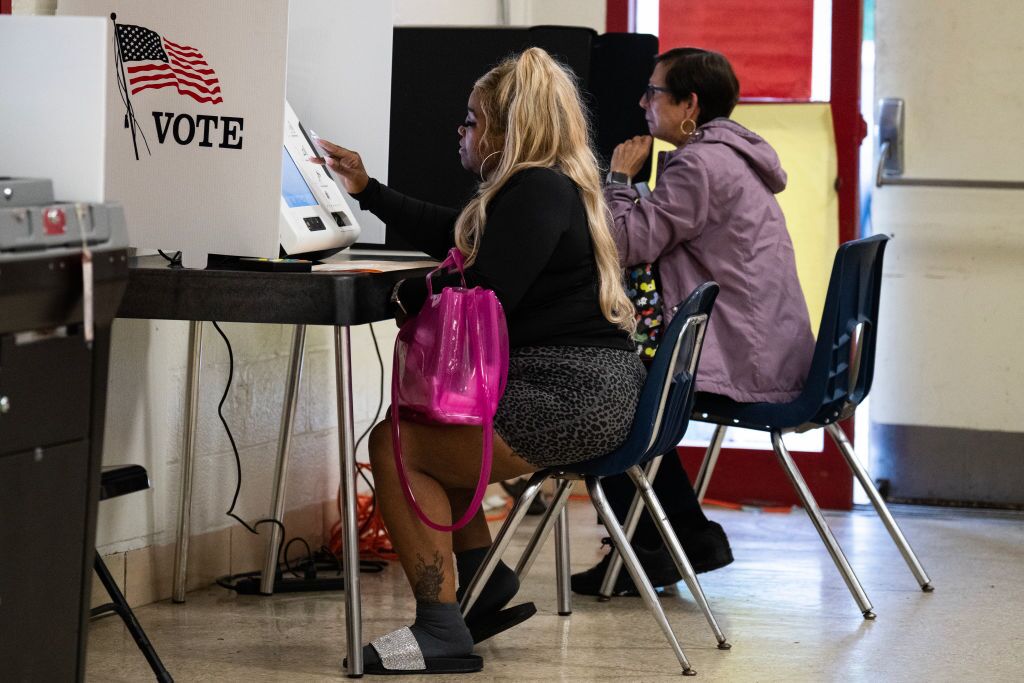
Affidavit: Second arrest made in East Commerce Street shooting of 19-year-old
June 27, 2025
California Legislature to vote on budget capping immigrant health care access to close $12B deficit
June 27, 2025In recent weeks, a wave of rumors has surfaced online suggesting the 2024 election may have been “stolen” or, more specifically, tampered with due to faulty machines. While many of these claims remain vague or speculative, some are beginning to gain traction across social media platforms and alternative news sites.
In the interest of democracy, transparency and election security, I reached out to a group of leading experts—many of whom work at the intersection of voting rights, cybersecurity and public trust—to share two examples of the kinds of articles I’ve seen on this topic, and ask for their take.
What follows are responses from some of the country’s most experienced voices on election integrity. Their insights are a valuable reminder that while election systems are not perfect, there is currently no credible evidence supporting claims of widespread vote manipulation in 2024. Instead, these experts highlight what’s real, what’s theoretical and where our attention should actually be focused as we work to protect democracy.
With permission, I’m sharing their responses here, lightly edited for clarity.
Is there any credible indication that election systems were compromised or that the outcome was manipulated?
Barbara Simons, board chair at Verified Voting and former president of Association of Computing Machinery:
I am aware of the chatter about claims that the 2024 election was tampered with due to faulty machines. All such chatter that I’ve seen is based on a case in Rockland County, N.Y. There is no evidence from Rockland County or elsewhere that Kamala Harris actually won the election.
Before getting into the situation in Rockland, I want to emphasize that despite significant progress, our elections are still vulnerable. Although most states do check, or audit, the results, they are not always rigorous enough.
Our paper ballots are tabulated by computers (aka scanners) and you can’t simply trust computers: that’s why audits matter. The goal of the post-election audits should be either to confirm the computer-declared results or determine the correct results via a full manual recount.
The gold standard of post-election ballot audits is called Risk Limiting Audits. If RLAs, combined with a strong chain of custody of the ballots, were used everywhere in a transparent fashion, not only could we have confidence in the declared results, but there would be much more trust in elections.
Here is one of the sensational headlines: “Kamala Harris won the U.S. elections: Bombshell report claims voting machines were tampered with before 2024.” The headline is misleading. No one involved with the case is claiming that Harris actually won.
The results of the 2024 election in Rockland County, N.Y., are being questioned because there are several districts in which Harris received zero votes, while Sen. Gillibrand received hundreds. The plaintiffs want a full hand recount.
I support the call for a full hand recount, if for no other reason than to clear up any doubts about the outcome and to check on the machines. However, according to Politico:
“Yet the numbers aren’t a surprise to local political observers — they’re actually extremely common in areas where Orthodox Jewish communities typically vote as blocs, for both Democratic and Republican candidates.
“’The organization is so tight that they’re able to vote for a candidate regardless of which party line they’re on, and can deliver, in many cases, 100 percent of the vote,’ said former state Sen. David Carlucci.
“Unusual vote breakdowns that don’t follow traditional party lines are the norm in Rockland and Orange counties. Democrat Andrew Cuomo won the Hasidic town of Palm Tree 4,521 to 279 in 2018; Trump won it 6,277 to 80 two years later.”
Susan Greenhalgh, senior advisor on election security at Free Speech For People:
This was the most serious election security breach known in U.S. history, but even though it was a multistate scheme, it was not investigated or prosecuted by the Garland DOJ or the Special Counsel.
At Free Speech For People, we’ve been tracking these claims and have some insights to offer. What’s most important to recognize here is that these posts offer a theory that supposedly would enable tampering, but no evidence of voter manipulation.
Not all of the claims in these posts hold up to scrutiny. For example, the de minimis “Engineering Change Orders” or ECOs cited don’t appear to actually include the use of the smart Tripp Lite UPS power supplies the posts are most concerned about. This is a signal to me that these assertions need a very critical eye.
By focusing on this theory, (which seems to have a few gaps) I think it misses the bigger picture by assuming that the systems could only be compromised if we can find a way the systems can be attacked remotely via these Tripp Lite devices. Unfortunately, we know that the voting machines have well-known and significant vulnerabilities, and could be compromised by insider access or by corrupted programming vendors without internet access. Despite all the claims to the contrary, these machines can include wireless internet networking access, which makes them vulnerable to remote attacks.
Furthermore, we know that following the 2020 election, operatives hired by Trump’s attorneys improperly accessed voting machines and made copies of the software, and that software was covertly shared with a network of other Trump supporters and technicians. See: “Copied voting systems files were shared with Trump supporters, election deniers,” The Washington Post
This was the most serious election security breach known in U.S. history, but even though it was a multistate scheme, it was not investigated or prosecuted by the Garland DOJ or the Special Counsel. Nor were there any actions taken to track down how extensively the software was shared, nor were there any mitigations adopted. See: “Trump was implicated in a vote machine theft. Where is DOJ?” Slate
A competent attacker (especially one with copies of the software!) could probably devise many different attacks through different vectors because we know the systems are poorly secured. But just hypothesizing how it could be done (when we already know it can be done) isn’t the same as having evidence it was done.
I found this Substack in response to be very appropriate: “Part 3: She Won. Or Did She? A Deeper Look and a Request For More Investigation” from the Substack, Deeper Look with Michael Sellers.
Spokesperson from the League of Women Voters:
LWV hasn’t done a ton of deep dive into this matter, but I personally trust the diligence of Charles Stewart of MIT—he has been working on election administration for some time and he recently did a Substack on the subject.
Elections are imperfect, but we will have enough ability to recount these issues and be able to determine if there is a problem – I don’t see anything here that points to any real evidence of an issue, yet.
Michael Daniel, president and CEO of Cyber Threat Alliance:
The truth is much harder to accept, so people reject it.
During the run-up to the 2016 election, after we had discovered the Russian intrusion in the Democratic party, I led an effort on the National Security Council to look into the security of voting machines. While it remains true that any individual voting machine has vulnerabilities (although fewer than in 2016), manipulating outcomes at scale through voting machines is very difficult.
1. Most voting machines are offline most of the time. Sometimes those updates are made at a very early point in a race, well before the shape of the race is fully known.
2. It would be very hard to hide malware that would change the results of cast ballots from a post facto review. In other words, a deep dive into the code would almost certainly reveal the manipulation.
3. If someone wanted to do manipulation, but not get noticed, then they would want the manipulation to be small, percentage-wise and certainly within the margin of error. But if the chance to introduce malware only occurs early on, then how does the manipulator know how much to change without being noticed but still affect the result? It becomes an impossible problem.
4. It also turns out that other parts of the election infrastructure, such as voter registration databases, pollbooks and the results reporting are far more vulnerable than the election machines themselves, but fraud claims don’t usually assert issues with those elements of the infrastructure.
I could go on, but the bottom line is that every election has anomalies, whether from small process problems or strange voting patterns. And in every election, the losing side has people who allege that the voting was rigged or manipulated. The truth is much harder to accept, so people reject it. I would not put much stock in these claims either.
Disclaimer: Ms. magazine is not taking a position on the veracity of the claims discussed herein. This piece is intended to share insights and perspectives from experts in the fields of democracy, cybersecurity and election integrity, in the interest of informed public discourse.
Special thanks to Vivian Rose for her editorial assistance in assembling this piece.
!function(f,b,e,v,n,t,s)
{if(f.fbq)return;n=f.fbq=function(){n.callMethod?
n.callMethod.apply(n,arguments):n.queue.push(arguments)};
if(!f._fbq)f._fbq=n;n.push=n;n.loaded=!0;n.version=’2.0′;
n.queue=[];t=b.createElement(e);t.async=!0;
t.src=v;s=b.getElementsByTagName(e)[0];
s.parentNode.insertBefore(t,s)}(window,document,’script’,
‘https://connect.facebook.net/en_US/fbevents.js’);
fbq(‘init’, ‘200522034604820’);
fbq(‘track’, ‘PageView’);
Great Job Roxanne Szal & the Team @ Ms. Magazine Source link for sharing this story.








